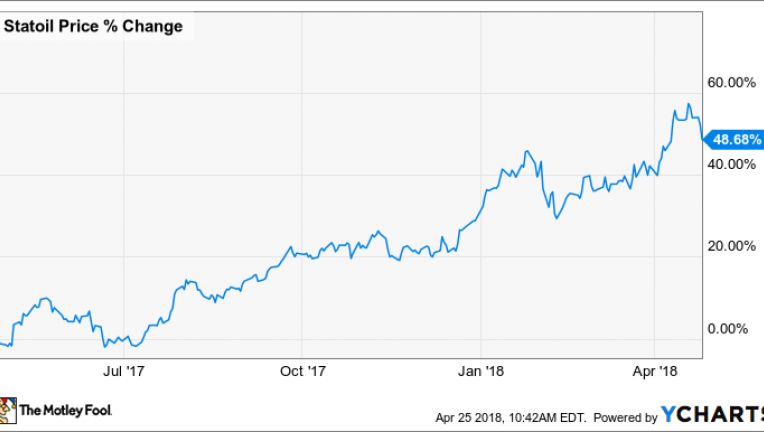Since AbbVie Inc.‘s (NYSE: ABBV) inception, investors have been fretting about the eventual demise of its lead drug, Humira. The aging blockbuster has slowed down a bit during the first three months of the year, but the rest of the company’s product lineup stepped up and delivered.
An immediate hit to Humira would still be devastating, but AbbVie’s first quarter report suggests the company can keep the needle moving forward even if the record-breaking biologic doesn’t reach the lofty revenue target the company touted last year. Here are a few hints in AbbVie’s first quarter report that suggest the foundations that this company has built under the house of Humira can stand on their own.
Continue Reading Below
Tough target to hit?
Humira’s most important U.S. patent expired last year, but Americans probably won’t have access to cheaper biosimilar versions until 2023. That’s why AbbVie confidently predicted annual Humira sales would climb to $21 billion by 2020 last October.
First quarter sales of the blockbuster rheumatoid arthritis therapy put it on pace to achieve $18.8 billion in a year. That’s certainly not bad, but it finished the previous quarter on a $19.6 billion annualized run rate.
AbbVie attributed 2017’s 18.5% gain in the U.S. to increasing patient populations and price increases, not a gain in market share. If insurers and pharmacy benefit managers play their cards right, anti-inflammatory drugs entering major markets could make it awfully hard to continue growing Humira sales with price increases alone.
New lead growth driver?
Advertisement
AbbVie’s new hepatitis C virus (HCV) treatment is priced to compete with Gilead Sciences (NASDAQ: GILD) market-leading treatments and the strategy’s working. Mayvret has been a disaster for Gilead’s HCV franchise, but it did more to push AbbVie’s needle forward than any other product during the first quarter. AbbVie reported $919 billion in HCV antiviral sales, $656 million more than during the same period last year and $409 million more than during the previous quarter.
AbbVie’s superstar leukemia tablet, Imbruvica put on another impressive showing. Sales of the tablets rose 39% to a $3.0 billion annualized run rate. Strong contributions from Mayvret and Imbruvica made this the first quarter I can remember where overall sales growth exceeded Humira’s.
Before we get too excited about Mayvret’s hugely successful launch, it’s important to remember the boom-and-bust nature of past HCV treatment launches. Gilead Sciences recorded $19.1 billion in HCV sales in 2015, but the segment hit an annualized run rate of just $6 billion in the fourth quarter. Don’t be surprised if chasing each other to the bottom causes Mayvret sales to plateau by the end of 2018.
Batters on deck
Just ahead of its earnings release, AbbVie sent its experimental psoriasis drug to the FDA. During studies supporting the application, risankizumab helped more than half of patients that received it to achieve complete skin clearance.
Risankizumab even wiped the floor with Johnson & Johnson‘s Stelara, a psoriasis drug on pace to pass $4 billion in annual sales this year. In one head-to-head trial, 82% of patients receiving AbbVie’s candidate achieved a 90% improvement versus just 44% in the group randomized to receive Stelara. That doesn’t necessarily mean risankizumab will pass the $4 billion mark as well, but it sure seems reasonable.
AbbVie also has an experimental oral rheumatoid arthritis therapy that could help the company maintain its edge in the space. Upadacitinib recently aced a head-to-head trial against Humira in one of several phase 3 trials designed to support an application the company thinks it can send to the FDA before the end of the year.
AbbVie thinks upadacitinib can add around $6.5 billion to the company’s top line at its peak, which looks a bit more achievable following Eli Lilly‘s (NYSE: LLY) recent date at the FDA. The agency called together an independent panel of experts to discuss a once-rejected application for baricitinib, a therapy similar to upadacitinib that’s already generating significant sales in the EU. There were a lot of ins and outs to consider, but I expect the regulator will insist on another lengthy study for Lilly’s drug that will clear the runway for upadacitinib’s potential launch in 2019.
A bargain buy
A strong first quarter inspired management to raise its full-year adjusted earnings forecast a few percentage points higher to a range between $7.66 and $7.76 per share. That estimate represents a stunning year-to-year growth rate of 38%, but the stock price is still depressed to a level that doesn’t make sense given the company’s impressive first-quarter performance and late-stage development pipeline.
At recent prices, AbbVie’s shares trade at just 12.6 times the midpoint of the company’s new earnings prediction for the year. For comparison, the average stock in the benchmark S&P 500 trades at around 17.0 times forward estimates. Throw in a dividend that offers a 3.9% yield, and this stock looks like a hard bargain to pass on right now.
10 stocks we like better than AbbVieWhen investing geniuses David and Tom Gardner have a stock tip, it can pay to listen. After all, the newsletter they have run for over a decade, Motley Fool Stock Advisor, has quadrupled the market.*
David and Tom just revealed what they believe are the 10 best stocks for investors to buy right now… and AbbVie wasn’t one of them! That’s right — they think these 10 stocks are even better buys.
Click here to learn about these picks!
*Stock Advisor returns as of April 2, 2018
Cory Renauer owns shares of Gilead Sciences. The Motley Fool owns shares of and recommends Gilead Sciences. The Motley Fool has the following options: short May 2018 $85 calls on Gilead Sciences. The Motley Fool has a disclosure policy.

